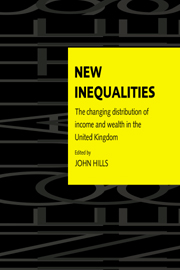Book contents
- Frontmatter
- Contents
- List of figures
- List of tables
- List of contributors
- Acknowledgements
- 1 Introduction: after the turning point
- Part I Income distribution
- Part II Components of income
- 6 What has happened to the wages of men since 1966?
- 7 Women's pay and family incomes in Britain, 1979–91
- 8 More work in fewer households?
- 9 Self-employment and the distribution of income
- 10 Fairer or Fowler? The effects of the 1986 Social Security Act on family incomes
- Part III Spatial aspects
- Part IV Income and wealth
- Bibliography
- Index
6 - What has happened to the wages of men since 1966?
from Part II - Components of income
Published online by Cambridge University Press: 22 September 2009
- Frontmatter
- Contents
- List of figures
- List of tables
- List of contributors
- Acknowledgements
- 1 Introduction: after the turning point
- Part I Income distribution
- Part II Components of income
- 6 What has happened to the wages of men since 1966?
- 7 Women's pay and family incomes in Britain, 1979–91
- 8 More work in fewer households?
- 9 Self-employment and the distribution of income
- 10 Fairer or Fowler? The effects of the 1986 Social Security Act on family incomes
- Part III Spatial aspects
- Part IV Income and wealth
- Bibliography
- Index
Summary
Introduction
The gap between rich and poor has increased dramatically over the last 20 years and the incomes of the bottom 10 per cent were no higher in 1991 than in 1967 (see Goodman and Webb, 1994). Wages are an important part of household income and the trends in the dispersion of wages mirror very closely the trends in the dispersion of income. Knowing the reasons for the changing structure of the wage distribution is thus crucial to an understanding of the trends in overall household income.
This chapter uses 27 years of data from the Family Expenditure Surveys over the period 1966–92 to describe and explain changes in the structure of male wages. We look at the evolution of wage differentials within and across different groups of workers and relate the changing wage structure to the changes in the structure of supply and demand. The analysis of the growth of women's wages over time is complicated because some women withdraw from the labour market at various points in their life-cycle to have children or work in the home and it is likely that the timing of this move will be affected by wages. Thus we may see growth of wages with age for women, simply because those women who leave the labour market to have children have lower wages and not because the wages of any particular group of women are rising. Likewise we exclude young (aged under 23) and older (aged over 59) men from the analysis.
- Type
- Chapter
- Information
- New InequalitiesThe Changing Distribution of Income and Wealth in the United Kingdom, pp. 135 - 157Publisher: Cambridge University PressPrint publication year: 1996
- 5
- Cited by



